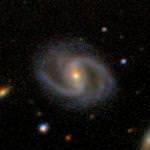[/caption]
As its name implies, a barred spiral galaxy is a spiral galaxy with a bar through the center.
Hubble introduced the ‘tuning fork’ scheme for describing the shapes of galaxies (“morphologies” in astronomer-speak) in 1936. In this, the two arms of the fork are barred spirals (from SBa to SBc) and spirals without bars (from Sa to Sc); the S stands for spiral, B for ‘it’s got a bar’, and a/b/c for how tightly wound the spiral arms are. This was later extended to a fourth type, SBm and Sm, for irregular barred spiral galaxies which have no bulge.
In 1959, Gérard de Vaucouleurs extended the scheme to the one perhaps the most commonly used by astronomers today (though there’ve been some mods since). In this scheme spirals without bars are SA, and those which have really weak bars are SAB; barred spirals remain SB. He also added a ‘d’ (SAd, SBd), and a few other things, like rings.
About half of spiral galaxies are barred; examples include M58 (SBc), M61 (SABbc), the Large Magellanic Cloud (LMC, Sm), … and our own Milky Way galaxy!
The bars are mostly stars (usually), unlike spiral arms (which have lots of gas and dust besides stars). The formation and evolution of bars is an active area of research in astronomy today; they seem to form from close encounters of the galaxy kind (galaxy near-collisions), funnel gas into the central bulge (where the super-massive black holes there snack on it), and are sustained by the same density waves which keep the arms alive.
Why not join the Galaxy Zoo project, and have some fun classifying spiral galaxies into whether they have bars or not (and getting to see some amazing sights too)?
Hubble Early Release Observation of Barred Spiral NGC 6217, Two Galaxies Walk Into a Bar…, and The Milky Way Has Only Two Spiral Arms; just some of the Universe Today stories on barred spiral galaxies.
Astronomy Casts featuring barred spiral galaxies include The Story of Galaxy Evolution, and Galaxies.


